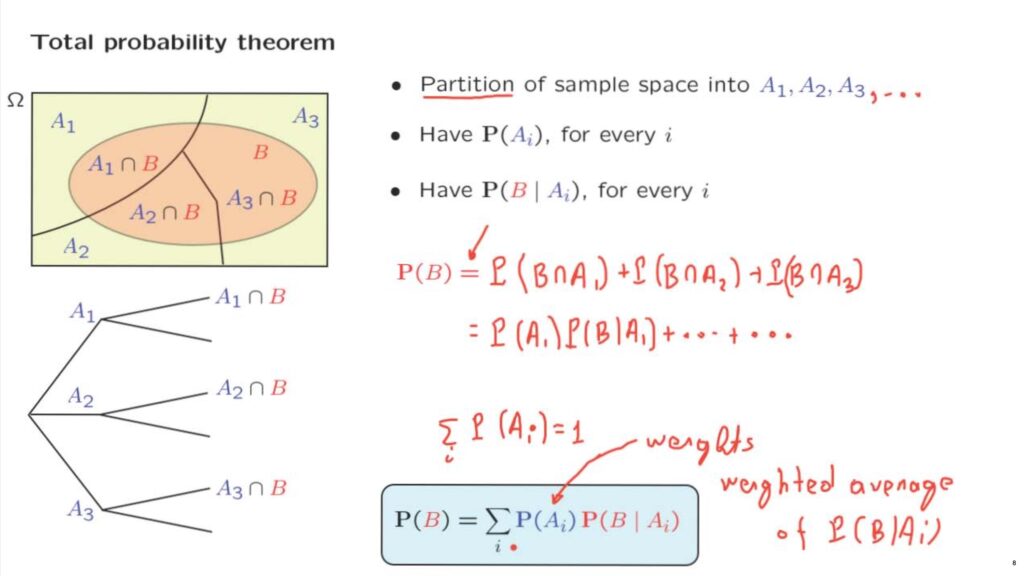Let us now revisit the second calculation that we carried out in the context of our earlier example.
In that example, we calculated the total probability of an event that can occur under different scenarios.
And it involves the powerful idea of divide and conquer where we break up complex situations into simpler pieces.
Here is what is involved.
We have our sample space.
And our sample space is partitioned into a number of subsets or events.

In this picture we take that number to be 3, so we’ll have it partitioned into three possible scenarios.
It is a partition which means that these events cover the entire sample, space and they’re disjoint from each other.
For each one of the scenarios we’re given their probabilities.
If you prefer, you can also draw this situation in terms of a tree.
There are three different scenarios that can happen.
We’re interested in a particular event, B.
That event B can happen in three different ways.
It can happen under scenario one, under scenario two, or under scenario three.
And this corresponds to these particular sub-events.
So for example, this is the event where scenario A1 happens.
And then event B happens as well.

In terms of a tree diagram, the picture becomes as follows.
If scenario A1 materializes, event B may occur or event B might not occur.
Finally, we are given conditional probabilities that event B will materialize under each one of the different possible scenarios.
Under those circumstances, can we calculate the probability of event B? Of course we can.
And here’s how we do it.
First we realize that event B consists of a number of disjoint pieces.
One piece is when event B occurs together with event A1.
Another piece is when event B occurs together with A2.
Another piece is when event B occurs together with A3.
These three sets are disjoint from each other, as we see in this picture.
And together they form the event B.
Therefore, the probability of B is going to be, by the additivity axiom of probabilities, equal to the sum of the probabilities of these sub-events.
Furthermore, for each one of these sub-events we can use the multiplication rule and write their probabilities as follows.

The probability that B and A1 both occur is the probability that scenario one materializes times the conditional probability that B occurs given that A1 occurred.
And then we’re going to have similar terms under the second scenario and a similar term under the third scenario.
So putting everything together, we have arrived at a formula of this form.
The total probability of event B is the sum of the probabilities of the different ways that B may occur, that is, B occurring under the different scenarios.
And those particular probabilities are the product of the probability of the scenario times the conditional probability of B given that scenario.
Now, note that the sum of the probabilities of the different scenarios is of course equal to 1.
And this is because the scenarios form a partition of our sample space.
So if we look at this formula here, we realize that it is a weighted average of the conditional probabilities of event B, weighted average of the conditional probabilities where these probabilities of the individual scenarios are the weights.
In words, the probability that an event occurs is a weighted average of the probability that it has under each possible scenario, where the weights are the probabilities of the different scenarios.
One final comment– our derivation was for the case of three events.
But you can certainly see that the same derivation would go through if we had any finite number of events.
But even more, if we had a partition of our sample space into an infinite sequence of events, the same derivation would still go through, except that in this place in the derivation, instead of using the ordinary additivity axiom we would have to use the countable additivity axiom.
But other than that, all the steps would be the same.
And we would end up with the same formula, except that now this would be an infinite sum over the infinite set of scenarios.
